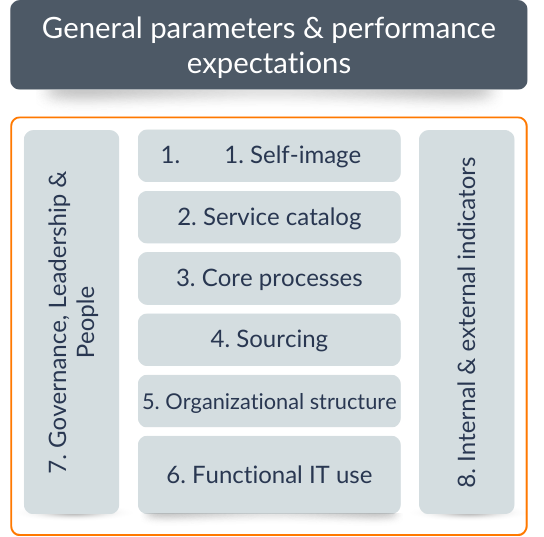Start Your Expedition
HR Strategy & HR TOM - The key to a Future-proof HR Organization
HR is at the heart of corporate transformation. How should HR reposition itself? We work together to create the basis for an effective, agile and sustainable HR organization. Always with a clear HR strategy and a complete HR TOM.
HR Strategy & HR TOM - More than just an organizational chart
A professional HR Target Operating Model (HR TOM) is much more than an organizational chart. It defines how your HR works, what added value it creates and what role it plays in the company. Together, we develop an HR strategy that provides orientation and integrates all relevant building blocks with a modular HR TOM: From HR service architecture to governance and IT support.
Our strength: We don't deliver theory, but a tried-and-tested, customizable model that makes your HR efficient.
The challenges - Why HR Strategy & HR TOM are crucial now
- Business transformation requires an equally transformed HR organization
- HR must reposition itself strategically, rather than reorganize operationally
- Many HR TOM initiatives end at the organizational chart - they lack the strategic foundation
- Lack of clarity about HR services, roles and service architecture inhibits efficiency
- HR is rarely perceived as a strategic business partner - this changes with a well-founded HR strategy and a complete HR target operating model
A good HR Tom is recognisable when it doesn't only work on paper, but also has an impact in everyday life. For HR, managers and the entire business.
Our Approach

Our HR TOM model: Eight building blocks for a future-proof HR organization
A strong HR Target Operating Model (HR TOM) is not created by a new organizational chart alone - but by the interaction of central design areas. Our 4C TOM model (Target Operating Model) comprises eight modules that can be considered together or individually. Individual modules can be deepened as required - modular, practical and compatible with your HR strategy.
Overview of the 8 modules:
- Self-image: What is the mission of HR? Clarification of purpose, role and contribution to the company's success.
- Service catalog: What services does HR provide - for whom, in what depth and with what added value?
- Core processes: How do the central HR processes work and how are they geared towards efficiency and impact?
- Sourcing: How are external resources, partners and tools integrated in a targeted manner?
- Organizational structure: How is HR structured - roles, responsibilities, control logic?
- Functional use of IT: Which systems and tools support HR work today and in the future?
- Governance, leadership & people: How are people managed, who makes decisions - and with what authority?
- Indicators & control: Which KPIs, reports and metrics effectively control the HR function?
Flexible & modular: You don't have to start with all eight modules. A focused introduction is often enough. We provide you with targeted support where the greatest leverage for your HR strategy lies.
Why 4C?
Your partner for HR strategy & HR TOM
We combine practical HR expertise with top-level strategic consulting. Our teams consist of experienced HR professionals, who have held management responsibility in HR functions, and consultants who can shape complex transformations. We know both sides: the challenges of day-to-day HR work and the requirements for a functioning HR operating model.
- What sets us apart: Many start with an organizational chart - we start with the right questions: What is the self-image of your HR? What services should HR provide in the future? From this, we jointly derive the structure and design of your HR TOM - on the basis of eight holistically conceived modules, not just one.
- Consulting with practical relevance: We don't deliver theory, but well-founded and practicable solutions - from practice for practice.
- Our approach is modular and flexible: you don't have to tackle all elements at the same time. We also work on individual modules in a targeted manner - e.g. governance, service architecture or role models - with the same quality standards as in the overall model.
- Our goal: an HR target operating model that not only works on paper, but has a real impact - strategically, operationally and culturally.
Near-Term-Shifts in HR Operating Model
|
Near-Term-Shifts in HR Operating Model A study by OTH Regensburg & 4C GROUP AG |
The digital transformation and dynamic market conditions call for new adaptation strategies in human resource management (HRM). But how can HR successfully support short-term change, so-called near-term shifts, while promoting the strategic development of the organization? Our latest study provides well-founded insights and practical recommendations for companies that want to meet these challenges.
Find out which strategic adjustments are necessary to future-proof HR - from the implementation of new technologies and flexible working models to data-driven decision-making. Discover how companies can strengthen HR as a strategic partner of the management level and develop the necessary skills for the coming requirements in a targeted manner.
Contact us today to find out more about how we can support you with your HR Operating Model.
More Topics
Your Experts
We are your experts in HR strategy and in the (further) development of your HR target operating model. Feel free to contact us directly:
We are here for you
We would like to point out that this website only offers a limited insight into our services. Our expertise and range of services cannot be fully represented on this platform. For individual advice and to address your specific concerns in the best possible way, we cordially invite you to contact us directly so that we can offer you tailor-made solutions.
Thank you for your trust. We look forward to hearing from you.











